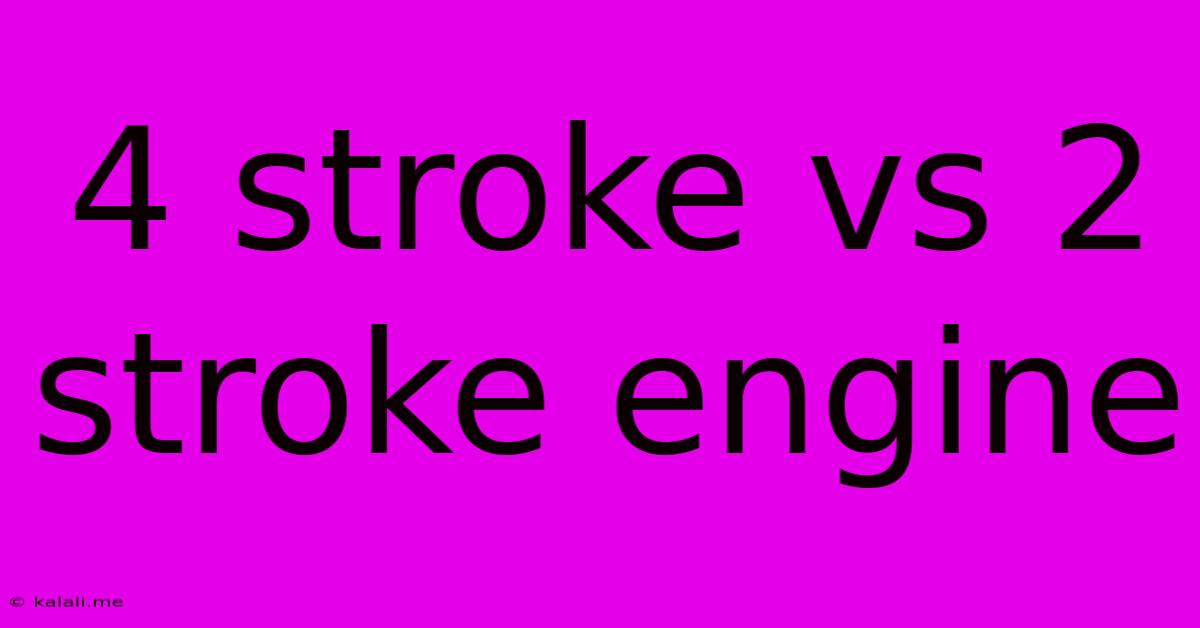4 Stroke Vs 2 Stroke Engine
Kalali
Jun 02, 2025 · 3 min read

Table of Contents
4-Stroke vs. 2-Stroke Engines: A Comprehensive Comparison
Choosing between a 4-stroke and a 2-stroke engine often depends on the application. This article delves into the key differences between these two engine types, highlighting their advantages and disadvantages to help you make an informed decision. Understanding their distinct operating principles, power delivery, maintenance requirements, and environmental impact is crucial for any potential user.
Understanding the Fundamental Differences
The core distinction lies in the number of piston strokes required to complete one power cycle. A 4-stroke engine completes this cycle in four strokes – intake, compression, power, and exhaust – while a 2-stroke engine achieves it in just two – compression and power. This fundamental difference significantly impacts performance, efficiency, and maintenance.
4-Stroke Engine: The Workhorse
The 4-stroke engine is the dominant engine type in most applications, from cars and motorcycles to generators and lawnmowers. Its popularity stems from several key advantages:
- Higher Efficiency: The separate strokes allow for more complete combustion, leading to better fuel economy and less emissions compared to 2-stroke engines.
- Higher Torque at Lower RPMs: This makes them ideal for applications requiring pulling power, such as towing or hauling.
- Smoother Operation: The sequential strokes result in a smoother, less vibrating operation.
- Longer Lifespan: With less stress on components due to smoother operation and more complete combustion, 4-stroke engines generally have a longer lifespan.
- Lower Maintenance: Typically requiring less frequent maintenance, particularly lubrication changes.
However, 4-stroke engines also have some drawbacks:
- More Complex Design: The added complexity translates to a higher manufacturing cost.
- Heavier Weight: The more intricate design makes 4-stroke engines heavier than their 2-stroke counterparts.
- Lower Power-to-Weight Ratio: They generally produce less power per unit of weight compared to 2-stroke engines.
2-Stroke Engine: Power and Simplicity
2-stroke engines are known for their simplicity and high power-to-weight ratio. They're often found in applications where lightweight and compact designs are crucial, such as chainsaws, scooters, and some smaller outboard motors. Their advantages include:
- Lightweight and Compact Design: Fewer moving parts and a simpler design lead to smaller and lighter engines.
- Higher Power-to-Weight Ratio: They produce more power relative to their weight compared to 4-stroke engines.
- Simpler Construction: The reduced number of components makes them less expensive to manufacture and easier to maintain.
However, 2-stroke engines suffer from some significant disadvantages:
- Lower Fuel Efficiency: Incomplete combustion leads to lower fuel economy and increased emissions.
- Higher Emissions: They produce significantly more harmful emissions, including unburnt fuel and hydrocarbons.
- Higher Vibrations: The simpler design leads to more vibrations, impacting smoothness and potentially lifespan.
- Requires More Frequent Maintenance: They generally require more frequent lubrication due to the mixing of oil and fuel.
- Shorter Lifespan: The higher stress on components often results in a shorter lifespan compared to 4-stroke engines.
Environmental Considerations: A Key Differentiator
The environmental impact is a crucial factor when considering 4-stroke versus 2-stroke engines. 4-stroke engines produce significantly fewer emissions, making them a more environmentally friendly choice. The reduced emissions contribute to cleaner air and a smaller carbon footprint.
Conclusion: The Right Engine for the Right Job
The optimal engine type depends heavily on the intended application. 4-stroke engines excel in applications demanding efficiency, longevity, and smooth operation, while 2-stroke engines shine in situations prioritizing lightweight design, compact size, and high power-to-weight ratios. However, the environmental impact should always be a significant consideration in the decision-making process. Understanding the strengths and weaknesses of each engine type will help you make the most informed choice.
Latest Posts
Latest Posts
-
Can A Question Be A Thesis Statement
Jun 03, 2025
-
Can A Standard Deviation Be Negative
Jun 03, 2025
-
In The Quest Vs On The Quest
Jun 03, 2025
-
Somebody Ever Broke The Laws Of Physics
Jun 03, 2025
-
Whats The Best Way To Gut A Thin Line Inmetal
Jun 03, 2025
Related Post
Thank you for visiting our website which covers about 4 Stroke Vs 2 Stroke Engine . We hope the information provided has been useful to you. Feel free to contact us if you have any questions or need further assistance. See you next time and don't miss to bookmark.